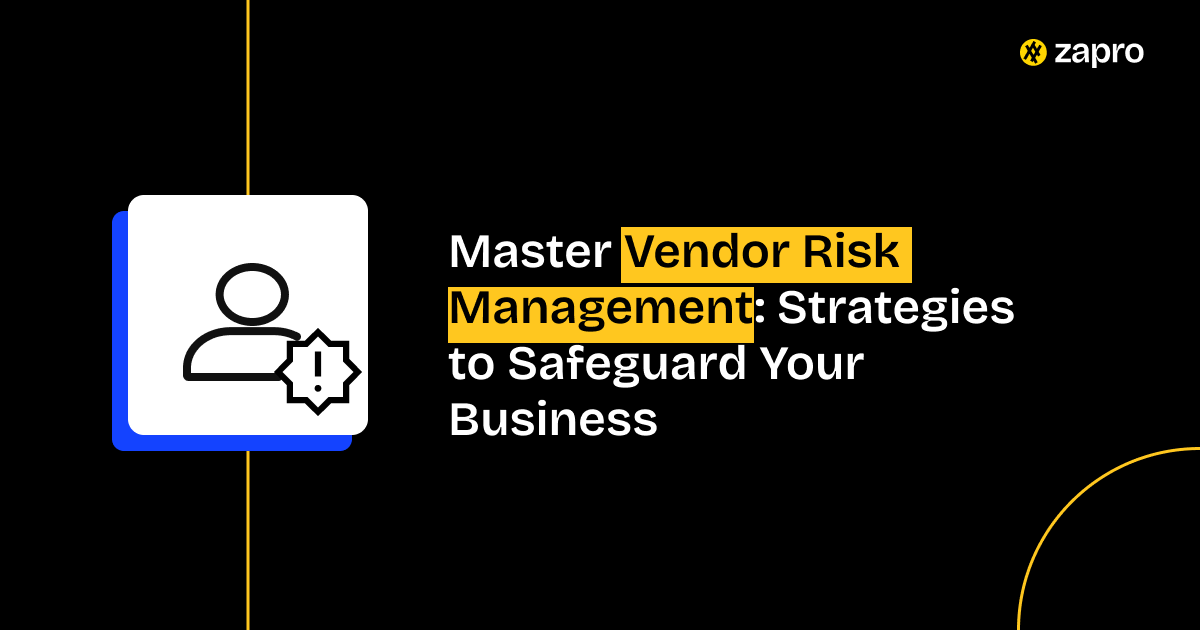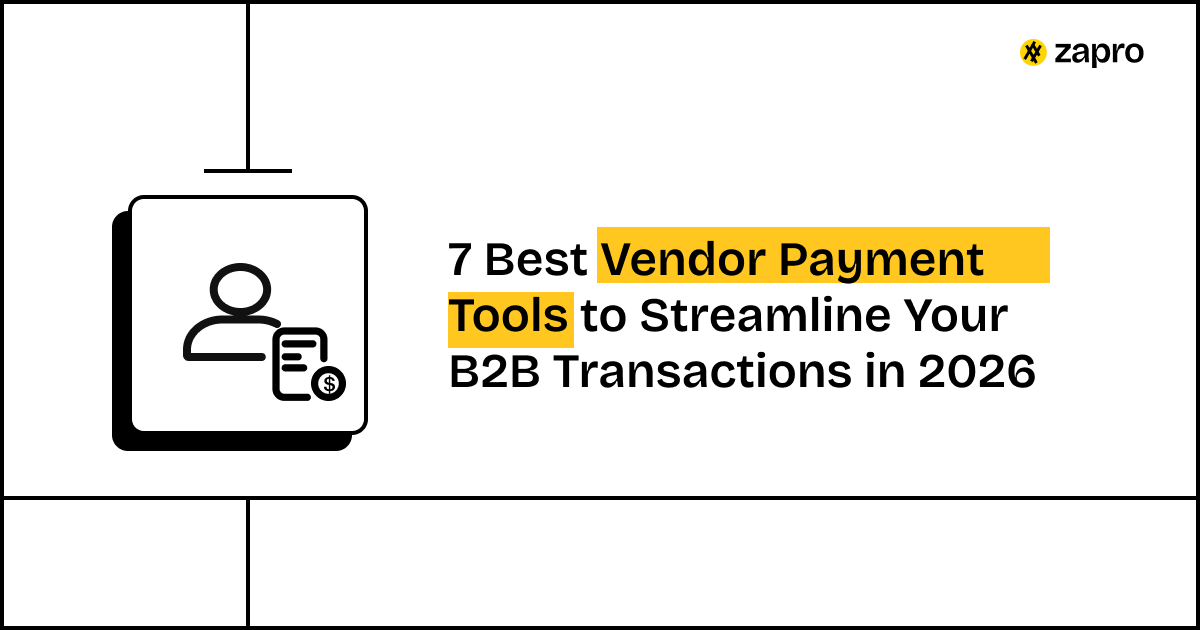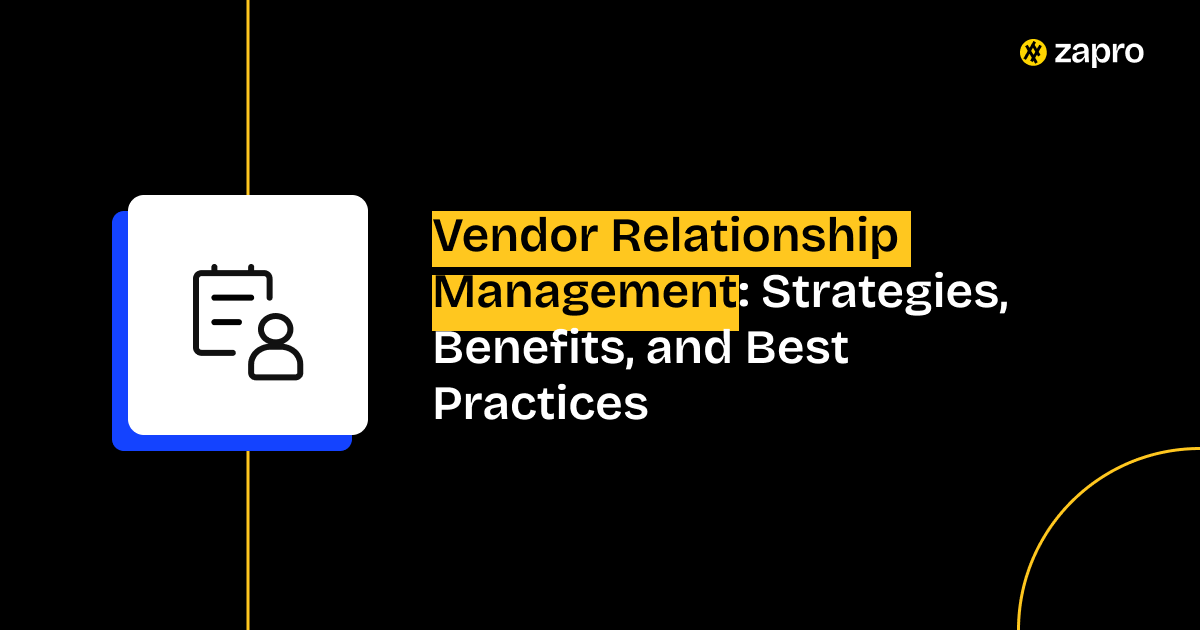You are Here: Vendor Management Solution >> Vendor Risk Management
Why Vendor Risk Management Matters More Than Ever
Organizations that rely on third-party vendors for essential services and products face a global economy that is extremely connected and rapidly moving. But with opportunity comes risk. Vendor Risk Management (VRM) has moved beyond basic compliance status to become a strategic necessity because of growing cyber threats and mandatory compliance and supply chain disruptions.
The Ponemon Institute reports that third party data breaches affect more than half of all organizations. This data represents more than a statistical figure because it serves as an alert for CPOs, Finance Directors, and Risk Managers. Your company’s vulnerabilities will mirror those of its vendors.
The following blog explores VRM strategies that span basic principles through technological best practices which suit decision makers at all stages of the process.
What Is Vendor Risk Management (VRM)?
The Vendor Risk Management process involves identifying risks of third-party vendors and suppliers along with their assessment and mitigation and ongoing monitoring. VRM extends past the basic requirements of vendor screening and initial assessments of procurement strategy to create an ongoing process which defends your organizational data and operations and reputation.
VRM functions as the fundamental system which supports supply chain stability. The program protects your business from financial losses and regulatory penalties and operational disruptions and maintains ethical and secure and sustainable supplier partnerships.
Key Categories of Vendor Risks
Every vendor you onboard brings potential risks. Here’s a breakdown of the key categories:
Financial Risk: Unexpected vendor management bankruptcy, pricing volatility, or unstable cash flow can derail your projects.
Operational Risk: Service interruptions, capacity limitations, or poor performance can harm delivery timelines.
Cybersecurity Risk: Data breaches, malware, or poor security hygiene can expose sensitive data.
Compliance & Regulatory Risk: Failure to adhere to laws like GDPR or HIPAA can result in massive penalties.
Reputational Risk: Association with unethical or non-compliant vendors can damage public trust.
Geopolitical/ESG Risk: Political instability, environmental impact, or poor labor practices can create ripple effects across global supply chains.
The 2024 IBM Cost of a Data Breach report demonstrated that third-party involved breaches cost organizations 12.5% more than other breaches.
Why is Vendor Risk Management Important?
Businesses heavily depend on outside vendors. A default vendor could impact the overall outcome and profits. Besides these, the vendor can leak valuable data, never adhere to regulations, or even bring your operations to a halt. In order to address such unanticipated threats, Vendor risk management helps evaluate them, identify and mitigate their risks, and monitor vendor changes.
The Rising Importance of Third-Party Risk in 2025
In 2025, companies don’t just use a handful of vendors; they rely on dozens, sometimes hundreds. From cloud apps to supply chains, your success depends on others. The problem? The more vendors you bring in, the more doors you open to cyber threats, regulatory trouble, and downtime. That’s why third-party risk is no longer something you “should” manage; it’s something you must.
Key Business Risks Without Proper VRM
Skip VRM and you’re rolling the dice with your business. Data breaches, fines, service outages; these are all common side effects when vendors aren’t properly vetted. Beyond the financial impact, your reputation and customer trust can be compromised overnight.
Benefits of a Strong Vendor Risk Management Program
A strong Vendor Risk Management program is about safety and security, and it also helps run the business seamlessly without any tensions. Having the perfect one in place helps implement a security framework that maps to your organization. The many benefits include increased security, increased consumer trust, more productive time for business growth, and cost savings.
What are Some Vendor Risk Management Examples?
Think of VRM in action like checking your cloud provider’s security standards, reviewing suppliers for GDPR compliance, or keeping scorecards on vendors that handle sensitive data. Even something as simple as monitoring a vendor’s financial health is part of the picture. These everyday checks add up to big protection.
Learn more about Zip Alternative.
How Do You Manage Vendor Risk?
You don’t manage vendor risk by chance; you do it with a plan. Firstly, identify and generate a list of critical vendors according to risk levels, then find details regarding their security and compliance posture. With these details in hand, you can onboard the right vendors, monitor overtime, and track their actions frequently to mitigate risks.
Step 1: Identifying and Classifying Vendors
The first and foremost step is to identify and classify the vendors. This is done by thoroughly learning who they are, what they can do, and a look into their past business history and transactions. Not every vendor is a defaulter or carries the same level of risk, but the idea is to put into place a system that can steer clear of such dangers. By using a supplier risk management framework, it is easy to classify high, medium, and low-risk vendors. Through this approach, the focus on which vendor to get more or less attention can be determined.
Step 2: Conducting Risk Assessments
After vendors are classified, conduct supplier risk assessments. The assessments would throw light on weak spots in cybersecurity, compliance issues, and financial stability that could pose a threat to your business. A structured supplier risk assessment procedure ensures identifying hazards that could negatively affect your organization’s ability to conduct business.
Step 3: Due Diligence and Vendor Onboarding
Onboarding is more than just paperwork; it is about making sure your vendors can deliver without exposing your business to unnecessary risk. A solid vendor risk management framework checks certifications, compliance history, and past performance. Besides these, the vendor’s financial risk assessment should also perform a thorough check to confirm that the vendor is financially strong to meet commitments. Completing this assessment in the beginning helps build trust, attain long term goals, and save business from future issues.
Step 4: Setting Risk Mitigation Strategies
Third-party vendors and suppliers are risky. However, the right supplier risk mitigation strategy helps to steer clear of the dangers. A good supplier risk mitigation strategy may include solid contracts, periodic security checks, and having a backup plan ready to address vendor risks. A well-defined supplier risk management process helps you balance risk without slowing down operations. The goal is to manage all types of vendor risks, not eliminate them completely.
Step 5: Continuous Monitoring and Auditing
Ongoing monitoring and auditing are important to a business because vendor risk can arise at any time. A supplier that passed last year’s supplier risk analysis could be a weak point today due to new threats or financial trouble. Regular audits are a critical part of any vendor risk management framework. They make sure you’re always working with up-to-date information instead of old assumptions.
Step 6: Leveraging Technology and VRM Tools
Managing dozens of vendors manually just doesn’t scale anymore. Modern GRC vendors and cybersecurity vendor management software platforms simplify the job with automation, real-time alerts, and centralized dashboards. These GRC software vendors save time and reduce blind spots by making data easy to track. With the vendor risk management market growing fast, the right tools can completely change how you manage suppliers.
Smarter Vendor Risk Management, Made Simple

The Vendor Risk Management (VRM) Lifecycle: From Onboarding to Offboarding
Effective Vendor Risk Management (VRM) as a practice is a continuous activity throughout the procurement lifecycle to guarantee that organizations only deal with reputable and compliant vendors. A successful VRM process, in general, is characterized by these steps:
1. Vendor Discovery & Initial Assessment
First, vendors should be evaluated for their financial soundness, security, compliance, and ESG (Environmental, Social, Governance) policy implementation. Drops in safety standards among key suppliers could become a nontrivial source of disruptions in an organization’s supply chain. To avoid onboarding such vendors, thorough vendor risk assessments are recommended at this stage. Through risk discovery, organizations can even shortlist the most critical vendors for further evaluation and research, regardless of their risk exposure volume.
2. Contract Negotiation
Make sure to include risk-sharing clauses, service-level agreements (SLAs), and data protection requirements during contract negotiations. The negotiation process should outline strategies for supplier risk mitigation on the organization’s behalf. Besides charting set responsibilities and expectations, well-designed contracts also offer incentives.
3. Ongoing Monitoring
After a vendor has been onboarded, their performance, compliance, and any risks arising should be continuously monitored. Regular oversight is the vendor risk management process in which the customer sits. It allows organizations to spot possible occurrences early, thereby preventing the transition of minor concerns to major disturbances.
4. Performance Management
Monitor vendors’ performance through key performance indicators (KPIs). Performance management provides organizations with the ability to identify and control vendor risk in a systematic manner. Furthermore, it also facilitates collaboration among the vendors, who thereby remain updated with the business objectives.
5. Offboarding / Exit Strategy
Create a safe and legal exit plan in case of vendor relationship termination, especially when it involves a data set that is confidential. The correct offboarding will reduce the risk of cyber security and compliance, as well as it will make sure a separation from a partnership will not cause any operational or reputational issues.
Learn about vendor management tools.
Essential VRM Strategies & Best Practices
The implementation of a resilient VRM program relies on the adoption of several best practices, which have the effect of standardizing and strengthening the vendor management.
Establish a Formal VRM Policy
Identify what, who, and how in terms of roles, responsibilities, and escalation across all departments. Consistency in handling vendor risk is safeguarded by a formal policy. Moreover, it makes sure accountability is the foundation of the organization in all its ranks.
Conduct Thorough Due Diligence
Check vendors’ financials, security certifications, and their legal histories in detail. Solid due diligence is the means of bringing hidden risks to light and directing the scoring of the risks. This stage is to ensure that the decision of selecting vendors is well-informed and the risk is kept at a minimal level.
Use Risk Scoring & Tiering
Identify high-risk vendors and assess them thoroughly. By risk tiering, organizations will be able to allocate resources in a more efficient manner and concentrate on those suppliers that have the potential for the most significant impact.
Leverage Procurement KPIs
Hold vendors to account by establishing and communicating clear performance benchmarks. Tracking KPIs will guarantee that the suppliers will be in line with the contractual obligations as well as with the risk expectations.
Automate Contract & Compliance Management
Employ technological tools to trace contracts, compliance needs, and regulations. Automation eliminates mistakes caused by human error and guarantees that standards for vendor risk management are kept.
Foster Strong Relationships
Instead of following traditional approaches to strengthen relationships with the vendors, keep it open and easy to approach. Keeping the communications simple and straight paves the way for proactive problem-solving and increases the sustainability of the supply chain.
The Role of Technology in Modern VRM
Technology has turned traditional VRM into an active risk intelligence platform which actively monitors risks instead of functioning as a manual compliance system. Here’s how:
AI-Powered Analytics: The combination of AI-Powered Analytics enables organizations to identify irregularities and make predictions about potential vendor breakdowns along with automated risk evaluation.
VRM Platforms & Dashboards: The VRM Platforms & Dashboards provide organizations with a unified platform for monitoring vendor performance while presenting risk alerts and compliance statuses.
Automated Due Diligence Tools: This VRM tool helps organizations to reduce human error while making vendor onboarding faster.
Real-Time Monitoring Tools: This provides continuous financial, security posture, and public reputation tracking for vendors.
The next evolution of VRM will occur through integrated GRC platforms with predictive risk analytics capabilities provided by machine learning technology.
How Zapro.ai Strengthens Your VRM Program
Zapro.ai serves as a powerful solution which supports all stages of your vendor management system.
Zapro.ai serves as a powerful solution which works to support every phase of the VRM lifecycle. Zapro’s tools make vendor management seamless from the time you bring new vendors onboard until you reassess established partners.

83% of organizations have experienced a security incident involving a third‑party vendor
Key Features of Zapro.ai for Proactive VRM
- Centralized Vendor Profiles: Maintain a single source of truth for each vendor.
- Automated Due Diligence Workflows: Customize checklists and questionnaires for different risk tiers.
- Performance Tracking Dashboards: Monitor KPIs, SLAs, and contractual obligations.
- Risk Scoring Engines: Use real-time data feeds and AI models to score vendors dynamically.
- Compliance Checklists & Audit Trails: Ensure preparedness for audits and regulatory reviews.
Zapro functions as an integration-ready solution which scales up to match existing ERP or procurement system deployments.
Case Study: How a Global Retailer Reduced Third-Party Risk by 35% with Zapro.ai
The multinational retail chain used Zapro.ai to transform their vendor risk management procedures. Through their implementation of automated onboarding and real-time monitoring and AI-based scoring systems they achieved the following results:
- Reduced vendor-related security incidents by 35%
- Cut vendor onboarding time by 50%
- Improved audit readiness by automating compliance documentation
RESULT: The combination of supplier confidence improvement and reduced disruptions led to better regulatory standing for the multinational retail chain.
Calculating the ROI of Investing in VRM with Zapro.ai
VRM investments create risk prevention value that exceeds traditional cost reduction benefits. Zapro.ai generates ROI through the following methods:
- The organization prevents data breach exposure through its prevention strategies which protect millions of dollars.
- Legal Fines Reduction: Compliance mandate prevention.
- Time Savings: Automate assessments and documentation.
- Operational Continuity: Ensure service delivery even during vendor crises.
The Zapro ROI Calculator provides users with the ability to determine their expected savings.
Use Zapro’s ROI Calculator to estimate your potential savings.
Choosing the Right VRM Solution: A Strategic Checklist
A Strategic Checklist must be used when selecting the appropriate VRM solution
The following aspects must be evaluated when selecting VRM software:
- Does it automate assessments and due diligence?
- Can it continuously monitor vendor performance and risk?
- The system needs to support customizations based on the specific regulatory requirements of your industry such as HIPAA and GDPR.
- Can it scale across global operations?
- Does it integrate with your ERP, procurement, and IT systems?
- Does it provide actionable insights and visual reports?
Why Zapro.ai Is Your Strategic VRM Partner
The platform of Zapro.ai operates as a VRM transformation partner beyond its status as software. Organizations gain future-ready resilient supply chains through Zapro’s AI-driven platform combined with customizable workflows and deep compliance support.
Are you prepared to enhance your vendor risk security? Contact Zapro.ai to request a customized demo.
Closing Thoughts
Vendor Risk Management has evolved from an optional practice into an absolute necessity. The implementation of proactive VRM strategies together with Zapro.ai platforms enables organizations to defend their operations and reputation while safeguarding their bottom line from uncertain vendor threat.

Transform the Way You Manage Vendor Risks
Zapro’s AI-driven VRM keeps your business protected and agile.
Frequently Asked Questions (FAQs)
1. How often should vendor risk assessments be conducted?
The risk assessment of vendors is supposed to be carried out during the initial phase (at onboarding), on a regular basis (e.g., annually or bi-annually), and in times of a vendor’s significant operational or financial change. In particular, it is advisable to keep a very close eye on suppliers categorized as high risk especially when talking about their cybersecurity and regulatory compliance.
2. What are the most common vendor risk management mistakes companies make?
The most significant of these mistakes are, not doing detailed supplier risk assessments, which can lead to missing new kinds of risks, disregarding the protection of the contract as well as not having a formal vendor risk management framework. Another typical error is the manual processes that are being actually used for the risk management whereas the software is for automation only but some companies still rely solely on manual work and do not take advantage of GRC software vendors for seamless risk management.
3. How much does vendor risk management software cost?
The price depends on the features, vendor, and the scale of the project. A basic solution from a GRC vendor can cost as little as a few thousands of dollars per year, while enterprise-level platforms can be as expensive as several tens of thousands or more. The pricing model is mostly based on the number of users, the number of suppliers tracked, and the level of automation provided.
4. What information should be included in a vendor risk register?
A vendor risk register ought to record each vendor’s financial status, supplier risk evaluations, compliance logs, contractual terms, and the categories of vendor risks identified. Incorporating risk scores, risk mitigation plans, and monitoring schedules allows decision-makers to have a snapshot of the situation at their fingertips.
5. How do you measure the effectiveness of your vendor risk management program?
The success of the program can be tracked through KPIs, for example, the time taken to resolve incidents, the degree of compliance, the amount of risk reduced over a period of time, and the results of audits. Conducting supplier risk evaluations and revising the vendor risk management process regularly creates a great cycle of continuous development. Moreover, the competent feedback from the operational teams coupled with the auditing functions of the GRC software vendors can provide reliability to the program.
Don’t miss our weekly updates
We’ll email you 1-3 times per week—and never share your information.

 Healthcare
Healthcare Financial Services
Financial Services Technology
Technology Venture Capitalist
Venture Capitalist Chief Procurement Officer
Chief Procurement Officer Chief Financial Officer
Chief Financial Officer




